Related Research Articles

A claw is a curved, pointed appendage, found at the end of a toe or finger in most amniotes.

A nail is a horn-like keratinous envelope covering the tips of the fingers and toes in most primates. Nails evolved from claws found in other animals. Fingernails and toenails are made of a tough protective protein called alpha-keratin which is found in the hooves, hair, claws and horns of vertebrates.

Troodontidae is a family of bird-like theropod dinosaurs. During most of the 20th century, troodontid fossils were few and incomplete and they have therefore been allied, at various times, with many dinosaurian lineages. More recent fossil discoveries of complete and articulated specimens, have helped to increase understanding about this group. Anatomical studies, particularly studies of the most primitive troodontids, like Sinovenator, demonstrate striking anatomical similarities with Archaeopteryx and primitive dromaeosaurids, and demonstrate that they are relatives comprising a clade called Paraves.
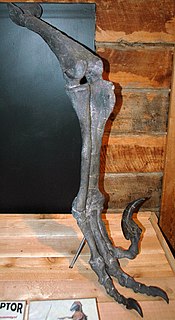
Utahraptor is a genus of large dromaeosaurid theropod dinosaur that lived in North America during the Early Cretaceous period. It was a heavy-built, ground-dwelling, bipedal carnivore. It contains a single species, Utahraptor ostrommaysi, which is the largest-known member of the family Dromaeosauridae.

The phalanges are digital bones in the hands and feet of most vertebrates. In primates, the thumbs and big toes have two phalanges while the other digits have three phalanges. The phalanges are classed as long bones.

The Pipidae are a family of primitive, tongueless frogs. The 41 species in the family Pipidae are found in tropical South America and sub-Saharan Africa.

A claw hammer is a tool primarily used for driving nails into, or pulling nails from, some other object. Generally, a claw hammer is associated with woodworking but is not limited to use with wood products. It is not suitable for heavy hammering on metal surfaces, as the steel of its head is somewhat brittle; the ball-pein hammer is more suitable for such metalwork.
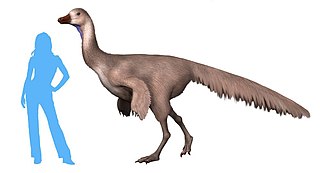
Arkansaurus is an extinct genus of ornithomimosaurian theropod dinosaur. It lived during the Albian and Aptian stages of the Early Cretaceous. The type and only species is Arkansaurus fridayi.

Masiakasaurus is a genus of small predatory theropod dinosaurs from the Late Cretaceous of Madagascar. In Malagasy, masiaka means "vicious"; thus, the genus name means "vicious lizard". The type species, Masiakasaurus knopfleri, was named after the musician Mark Knopfler, whose music inspired the expedition crew. It was named in 2001 by Scott D. Sampson, Matthew Carrano, and Catherine A. Forster. Unlike most theropods, the front teeth of M. knopfleri projected forward instead of straight down. This unique dentition suggests that they had a specialized diet, perhaps including fish and other small prey. Other bones of the skeleton indicate that Masiakasaurus were bipedal, with much shorter forelimbs than hindlimbs. M. knopfleri reached an estimated adult body length of around 2 metres.
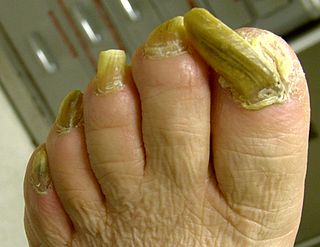
Onychogryphosis is a hypertrophy that may produce nails resembling claws or a ram's horn.
Draconyx is a genus of dinosaur from the Late Jurassic. It was an ornithopod which lived in what is now Portugal and was a herbivore. It was found in the Lourinhã Formation in 1991, and described by Octávio Mateus and Miguel Telles Antunes in 2001.

Noasaurus is a genus of ceratosaurian theropod dinosaur genus from the late Campanian-Maastrichtian of Argentina. The type and only species is N. leali.

Sinornis is a genus of enantiornithean birds from the Lower Cretaceous Jiufotang Formation of the People's Republic of China.

A cat's paw or cat's claw is a standard carpenter's tool, consisting of a round or hexagonal bar that curves at one end to form a pointed, cup-shaped tip with a V-shaped cleft for gripping nailheads. Popular retail outlets currently call these a claw bar if it has a claw on each end, or a moulding bar if it has a claw on one end and a flat pry bar on the other. It essentially works as a small crowbar. To use the tool the user holds the tool's shank with one hand and drives the claw around a nailhead with a hammer. When the V is firmly seated around the nail's shank, the users pull the bar back to raise the head, then finishes pulling the nail with the hammer's claw. The cat's paw is well designed for demolition work, but because it tears up the wood around the nailhead, it should not be used for finish work.

A grooming claw is the specialized claw or nail on the foot of certain primates, used for personal grooming. All prosimians have a grooming claw, but the digit that is specialized in this manner varies. Tarsiers have a grooming claw on second and third toes. With one possible exception, in the suborder Strepsirrhini, which includes lemurs, galagos and lorises, the grooming claw is on the second toe. The possible exception is the aye-aye, which has claws instead of nails on toes 2 through 5. There is some debate concerning whether any of these claws are grooming claws. Less commonly known, a grooming claw is also found on the second pedal digit of night monkeys (Aotus), titis (Callicebus), and possibly other New World monkeys.
In mammals, ungual tufts are tufts of hairs at the base of claws of the forefeet and hindfeet. Their presence has been used as a character in cladistic studies of the Cricetidae, a large family of rodents.
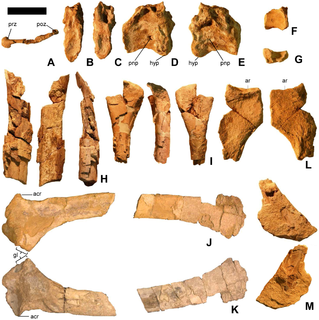
Martharaptor is an extinct genus of basal therizinosauroid theropod from the Lower Cretaceous of the Cedar Mountain Formation in Utah. It can be distinguished from other therizinosauroids by means of several features of the skeleton which were intermediate between early therizinosauroids such as Falcarius and Beipiaosaurus, and more "advanced" members of the group like therizinosaurids. The deep and homogeneous hand claws clearly differ from the case in early therizinosauroids, but the foot has not yet acquired the robust morphology of therizinosaurids.

Alierasaurus is an extinct genus of caseid synapsid that lived during the late Early Permian to Early Middle Permian in what is now Sardinia. It is represented by a single species, the type species Alierasaurus ronchii. Known from a very large partial skeleton found within the Cala del Vino Formation, Alierasaurus is one of the largest known caseids. It closely resembles Cotylorhynchus, another giant caseid from the Middle Permian San Angelo Formation in Texas. In fact, the only anatomical features that differ between Alierasaurus and Cotylorhynchus are found in the bones of the feet; Aleirasaurus has a longer and thinner fourth metatarsal and it has ungual bones at the tips of the toes that are pointed and claw-like rather than flattened as in other caseids. Aleirasaurus and Cotylorhynchus both have very wide, barrel-shaped rib cages indicating that they were herbivores that fed primarily on high-fiber plant material.
Tototlmimus is an extinct genus of ornithomimid dinosaur. Its remains were found from the late Cretaceous Packard Formation, in the Sonora state, México.
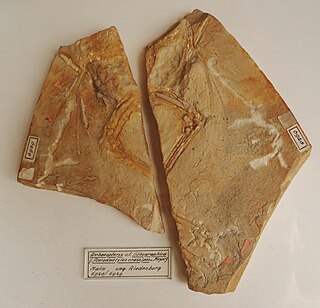
Ostromia is a genus of anchiornithid theropod dinosaur from the Late Jurassic Painten Formation of Germany. The genus contains a single species, O. crassipes, named by Christian Foth and Oliver Rauhut in 2017.